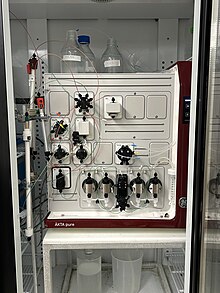
Back Ekskluziona hromatografija BS Größenausschlusschromatographie German Eksklusioonkromatograafia Estonian کروماتوگرافی اندازهای Persian Kokoerottelukromatografia Finnish Chromatographie d'exclusion stérique French Kromatografija isključenjem Croatian Cromatografia di esclusione molecolare Italian サイズ排除クロマトグラフィー Japanese Size exclusionchromatografie Dutch
 Equipment for running size-exclusion chromatography. The buffer is pumped through the column (left). | |
| Acronym | SEC |
|---|---|
| Classification | Chromatography |
| Analytes | macromolecules synthetic polymers biomolecules |
| Manufacturers | Cytiva, Bio-Rad, Bio-Works, emp Biotech, Knauer, Phenomenex. |
| Other techniques | |
| Related | High-performance liquid chromatography Aqueous normal-phase chromatography Ion exchange chromatography Micellar liquid chromatography |
Size-exclusion chromatography, also known as molecular sieve chromatography,[1] is a chromatographic method in which molecules in solution are separated by their size, and in some cases molecular weight.[2] It is usually applied to large molecules or macromolecular complexes such as proteins and industrial polymers.[3] Typically, when an aqueous solution is used to transport the sample through the column, the technique is known as gel-filtration chromatography, versus the name gel permeation chromatography, which is used when an organic solvent is used as a mobile phase. The chromatography column is packed with fine, porous beads which are commonly composed of dextran, agarose, or polyacrylamide polymers. The pore sizes of these beads are used to estimate the dimensions of macromolecules.[1] SEC is a widely used polymer characterization method because of its ability to provide good molar mass distribution (Mw) results for polymers.
Size exclusion chromatography (SEC) is fundamentally different from all other chromatographic techniques in that separation is based on a simple procedure of classifying molecule sizes rather than any type of interaction.[4]
- ^ a b Garrett RH, Grisham CM (2013). Biochemistry (5th ed.). Belmont, CA: Brooks/Cole, Cengage Learning. p. 108. ISBN 9781133106296. OCLC 1066452448.
- ^ Paul-Dauphin, S; Karaca, F; Morgan, TJ; et al. (6 Oct 2007). "Probing Size Exclusion Mechanisms of Complex Hydrocarbon Mixtures: The Effect of Altering Eluent Compositions". Energy & Fuels. 6. 21 (6): 3484–3489. doi:10.1021/ef700410e.
- ^ Kastenholz, B (29 Apr 2008). "Phytochemical Approach and Bioanalytical Strategy to Develop Chaperone-Based Medications". The Open Biochemistry Journal. 2: 44–48. doi:10.2174/1874091X00802010044. PMC 2570550. PMID 18949074.
- ^ Meyer, Veronika R.; Meyer, Veronika R. (2010). Practical high-performance liquid chromatography (5. ed.). Chichester: Wiley. ISBN 978-0-470-68218-0.
© MMXXIII Rich X Search. We shall prevail. All rights reserved. Rich X Search